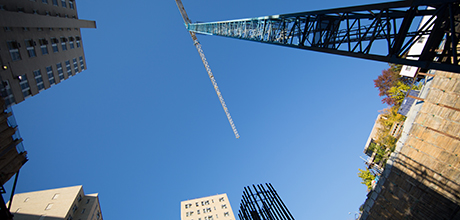One year ago last month ceremonial shovels turned the first of the dirt at the site of the Science and Engineering Hall, breaking ground on a three-year construction project that has quickly become a symbol of the university’s top-tier research ambitions.
George Washington Today sat down recently with two of the men who are doing the heavy lifting—Jack Adie, the project executive, and Brian Naumick, the senior project manager, both from Clark Construction—to get their perspective, one that’s often 75 feet below street level.
If the whole thing looks like Legos from the sidewalk, “I can assure you,” says Mr. Naumick, “that’s big construction equipment down there—even by construction standards.”
The crane, for instance, is 295 feet tall; big enough that it gets built by another crane. And that crane is so big it’s built by third crane.
With controlled blasting finished last month and the last of the digging-out underway, across much of the site construction crews are starting to build their way up.
Q: How’s it going?
Mr. Adie: It’s going well. We’ve removed quite a bit of material. There was probably 150,000 cubic yards of material to get out of the hole. And we’re about 90 percent done. A lot of it is rock.
We’re at the bottom on probably 80 percent of the hole and now we’re starting to come up. If you walked out there right now you’d see the footings [concrete blocks that will distribute the building’s weight] are in across about 60 percent of the south half and we’re working our way north.
Columns are now starting to be poured at the lowest level, and the foundation wall at the lowest level—around the perimeter of the site—is also going in.
Q: What’s next?
Mr. Adie: The sheeting and shoring [that support the perimeter of the site] for the most part is done. We’re pouring concrete footings, concrete columns, then we’ll start pouring the slabs. Next spring we’ll be approaching street level and you’ll start seeing the concrete structure of the building rise above that.
Q: What kinds of engineering challenges have you faced so far?
Mr. Adie: This is a pretty deep hole for a building downtown. Most of the buildings downtown only go down about four levels, if that, and that’s only if they have parking below the building. Here we have four levels of parking but those are underneath two levels of occupied space. We’re really going down six levels underground. It’s a relatively deep hole and a pretty big footprint, as well.
The hole just doesn’t stand up by itself, it has to be held back. So we put in what are called tiebacks—stranded wire cable that we drill 60 or 80 feet into the side of the excavation, and they go outside of what we call the “zone of influence” so they’ve got a place to anchor. They’re grouted and stressed, pulling one way while the dirt is pushing the other, to hold the vertical elements in place. And those vertical elements are what’s restraining the earth load—the earth wants to slide into the hole.
One big element that was not in the original plan was the bracing between JBKO and Fulbright. [These are the large, cylindrical pipes visible from the street.] That’s one of the few places on the site narrow enough to actually brace one side of the site against another. When we discovered that the rock was much lower than we anticipated it became a different engineering exercise in how we were going to support it over there.
Also, the project is a great example of many different retention systems that we use on many different jobs, but generally they don’t all present themselves on one project. We’ve got tangent pile walls, we’ve got tiebacks, we’ve got soldier beams and lagging, we have rakers, we’ve got cross-lot bracing, toe ties, vertical bars.
They’re all in response to either different materials you’re trying to restrain or to the surroundings—like rigid retention systems around the dorms, because you don’t want any movement, and ones that are a little more flexible against the street frontages.
Since there are buildings on three of the corners of this site, movement of the buildings is extremely sensitive to us. One of the things we installed here was a robotic monitoring station.
Mr. Naumick: We set points—hundreds of them—on the perimeter of the site and on the buildings along the edge, and it measures every point each hour. It’s continuously doing that, 24 hours a day, seven days a week. So we’re checking that not only is the face of the excavation not moving, but the face of the buildings, too.
The monitoring also sends notifications of movements beyond a prescribed tolerance. It’s a very precise instrument. Swelling and shrinking due to heat can cause it to send us an alert; wind; trucks on the road. And it’s used as a check against our manual monitoring, too.
Q: How’s the view from the crane?
Mr. Naumick: Probably pretty good in this neighborhood. I climbed one in Rosslyn for a 300-foot-tall building that we built. It’s not easy climbing.
You get a different level of appreciation for [the crane operator’s] technical capabilities. To be able to manage heavy equipment around the site—it’s pretty impressive what they can do when you see how small everything is from up there.
Mr. Adie: Yeah, everybody looks like ants. And the bucket [used by the crane] could probably hold all of us and this desk, easily.


